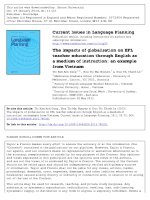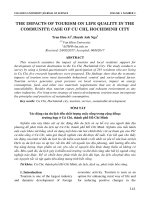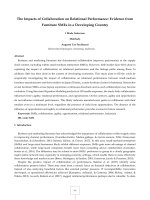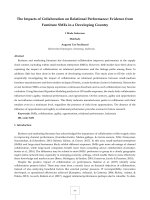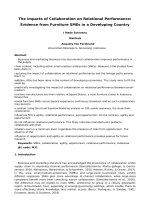Topic the impacts of smartphones on studentslives
Bạn đang xem bản rút gọn của tài liệu. Xem và tải ngay bản đầy đủ của tài liệu tại đây (1.11 MB, 17 trang )
<span class="text_page_counter">Trang 1</span><div class="page_container" data-page="1">
<b>Thuong Mai UniversityDepartment HTTTKT &TMDT</b>
DISCUSSION SUBJECT: ENGLISH 2
Lecturer: MS. Le Thi Tuyet Nga
<b>The impacts of smartphones onstudents'lives</b>
</div><span class="text_page_counter">Trang 2</span><div class="page_container" data-page="2">MEETING MINUTES (1) – GROUP 3...4
MEETING MINUTES (2) – GROUP 3...5
</div><span class="text_page_counter">Trang 3</span><div class="page_container" data-page="3"><b>GROUP DISCUSSION</b>
<b>ENGLISH 2</b>
<b>Topic: The impacts of smartphones on students'lives</b>
Group: 03 Class: 231ENTH151117 Teacher: Le Thi Tuyet Nga
Group preparation assessment:
Preparation assessment: List of students (in the order of presenting) (for the leader) 1 Nguyen Thi Ngoc 4 Vu Trong Khanh 3. Solution 5 Le Thi Phong Lan Positive impact 8 Nguyen Hoai Minh 1.Definition
<b>MEETING MINUTES (1) – GROUP 3</b>
</div><span class="text_page_counter">Trang 4</span><div class="page_container" data-page="4"><b>Time: from 9h50 to 10h20Date: 23/08/2023Place: G103</b>
<b>Members: : Nguyen Thi Ngoc Anh, Hoang Van Hoang, Nguyen Thi Thu Hong,</b>
Vu Trong Khanh, Le Thi Phong Lan, Pham Hoai Linh, Do Phuong Minh, Nguyen Hoai Minh.
<b>Contents for discussing:</b>
- Choosing leader and secretary
- Contributing ideas related to Technology problems and solutions and searching for the topic
<b>Conclusion: </b>
- Leader: Nguyen Hoai Minh - Secretary: Le Thi Phong Lan
- Selected topic: The impacts of smartphones on students'lives +
+ + ...
<b>Duties for members: Think and choose the most suitable topic out of the</b>
suggestions above to decide on next Wednesday.
<b>Head of the team: Secretary</b>
Nguyễn Hoài Minh Lê Thị Phong Lan
</div><span class="text_page_counter">Trang 5</span><div class="page_container" data-page="5"><b>MEETING MINUTES (2) – GROUP 3</b>
<b>Time: from 21h30 to 22h00Date: 20/09/2023Place: Google meet</b>
<b>Members: Nguyen Thi Ngoc Anh, Hoang Van Hoang, Nguyen Thi Thu Hong,</b>
Vu Trong Khanh, Le Thi Phong Lan, Pham Hoai Linh, Do Phuong Minh, Nguyen Hoai Minh.
<b>Contents for discussing:</b>
Presentation outline about “The impacts of smartphones on students'lives”
<b>Conclusion: PRESENTATION OUTLINE</b>
</div><span class="text_page_counter">Trang 6</span><div class="page_container" data-page="6">2.2.4 Game addtiction 2.2.5 Sleep disruption 2.2.6 Eyesight problems 2.2.7 Mental health
2.2.8 Lack of personal communication.
<b>3. Solutions to overcome the harmful effects that Smartphones bringCONCLUSION</b>
<b> Head of the team Secretary</b>
Nguyen Hoai Minh Le Thi Phong Lan
</div><span class="text_page_counter">Trang 7</span><div class="page_container" data-page="7"><b>OUTLINE</b>
<b>INTRODUCTION</b><b>1. Greeting</b>
Hello everybody, On behalf of group 3, I’d like to welcome you. Today, our presentation is about Impact of smartphones. Through the article we want to provide more information so that people know more about the impacts of smartphones on students’lives.
<b>2. Introducing the group’s members</b>
There are six people in my group, include: Leader is Hoai Minh, secretary is Le Lan, and other members Ngoc Anh, Van Hoang, Thu Hong, Trong Khanh, Hoai Linh, Phuong Minh.
<b>3. Introduce the group’s topic</b>
The impacts of smartphones on students' lives have become a significant topic of discussion in recent years. With the increasing prevalence of smartphones among students, it is essential to explore how these devices have influenced various aspects of their lives, both positively and negatively. From academic performance to social interactions and mental health, smartphones have undoubtedly left a lasting impact on students. This topic raises important questions about the benefits and drawbacks of smartphone usage, as well as the need for responsible and mindful use of these devices.
<b>4. Outlining the presentation</b>
There are three main parts in our presentation. The first is the introduction. The second is the definition of smartphones and the impacts of smartphones. Next is the solution section to address the impacts. The Final past is the conclusion.
<b>1. Definition of smartphone</b>
</div><span class="text_page_counter">Trang 8</span><div class="page_container" data-page="8">A smartphone is a mobile device that combines the functionality of a traditional mobile phone with features similar to those of a personal computer. Smartphones offer advanced capabilities beyond voice communication, including internet browsing, email, social networking, multimedia playback, GPS navigation, and a wide variety of applications (apps) that can be downloaded and installed to enhance the device's functionality. These devices typically have touchscreens for easy user interaction and operate on mobile operating systems such as iOS, Android, or Windows. Smartphones are designed to be versatile, portable, and provide users with a seamless integration of communication, entertainment, and productivity tools.
<b> 2. The impacts of smartphones 2.1. Positive impact</b>
2.1.1 Greater convenience
Take notes easily: Smartphones will help you improve your memory and retain important information. If you need to remember everything while working or studying but are too busy to do so, just open your phone and take notes. The device can also be used to track your daily work schedule. It can be said that smartphones have the ability to replace a notebook to help you control your work well.
Convenient payment: Paying bills will be more easy and convenient with a smartphone because you won't have to wait around for cash withdrawals. At the same time, you can directly pay bills, internet, television, and other services on your smartphone.
Additionally, smartphones bring many other benefits such as online learning, capturing lectures, and looking up Google Maps,...
2.1.2 Easier access to information and technology
</div><span class="text_page_counter">Trang 9</span><div class="page_container" data-page="9">Quick access to information: You can easily access the internet via smartphones to search for information, study materials, lectures, articles, and many other resources. This helps you save time and quickly update new knowledge.
Learning applications: There are many learning-related apps available on smartphones. To enhance your knowledge and study skills, you can download and use apps like dictionary apps, language learning apps, test preparation apps, and many others.
2.1.3 Easier communication
Smartphones have now become useful tools in everyday communication. You can send and receive short messages, photos, and videos via apps like Messenger, Zalo, SMS. You can chat, meet with your friends far away via applications like Zoom, Facetime easily and quickly. Besides, Facebook, Twitter, Instagram applications also allow you to interact and share content with friends and family. You can also participate in online groups and communities to socialize and share. Smartphones offer email and calendar features so you can send and receive emails right from your phone. You can manage your schedule and receive notifications about important events at any time.
2.1.4 More opportunities for creativity
In addition to the function of conveniently communicating, smartphones also help us find new things. Smartphones provide easy access to many sources of inspiration such as photos, videos, music, and other creative content. You can use apps like Pinterest, Instagram or YouTube to search and discover new ideas. As long as you have a smartphone, you will be able to unleash your creativity from pictures and short clips. You can create more creative content by combining them together through editing applications.
2.1.5 Social entertainment
</div><span class="text_page_counter">Trang 10</span><div class="page_container" data-page="10">After a long, tiring day of work, the phone is a useful tool for us to relieve fatigue. Because the phone integrates many functions such as surfing the web, watching movies, reading stories, etc. It can help you read the newspaper directly without having to hold a large, cumbersome newspaper. At the same time, users can also view and update the latest information at any time or any time they want to update information promptly. No matter where you are, no matter what you're doing, you can be entertained with a smartphone in your hand. With that benefit, the device can help you fill your downtime every day with valuable moments of entertainment and relaxation. Sometimes I also watch short clips on the tiktok application. There I can watch funny videos to dispel fatigue.
<b> 2.2. Negative impact</b>
2.2.1 Distraction while studying
In addition to the benefits that smartphones bring, it also has many limitations. First of all, smartphones will make us lose focus and reduce our learning efficiency. Currently, there is a group of students who use phones so much that they can be called "phone addicted". They mainly: play games, watch e-books, watch TV and movies, chat on Facebook, surf the Internet, listen to songs, take photos, etc. Hold their cell phones all day except eating and sleeping; Some students play with their phones during lunch break, before going to bed, at midnight and even during class; This will directly impact their learning results. 2.2.2 Cyberbullying
Besides, it can be said that smartphones are the fastest shortcut to the phenomenon of "cyber violence". Yes, social networks help generations of students access many new things and develop themselves a lot, but one extremely negative point that social networks bring is "cyber violence". Currently, there are many students who, due to lack of understanding in using smartphones and social networks, have fallen into "cyber violence". They can be victims or they can also be people who commit "cyber violence" on others.
</div><span class="text_page_counter">Trang 11</span><div class="page_container" data-page="11">Either way, it will seriously affect your psychology and self-worth, especially at a toddler age like this.
2.2.3 Examined malpractice
Besides the positive aspects, there are also disadvantages such as students using their phones to answer questions that should be answered using students' free resources. In fact, students still struggle in exams by bringing their phones into this room. Even though they know that if they bring a phone into this room, they will be kicked out of school and it will affect their studies, but they still intentionally make mistakes
2.2.4 Game addtiction
When using phones, people mainly use them for entertainment. But most students learn to play games. And there is a part that is game addiction. When students are game addiction, they will neglect their studies, drop out of school, skip classes, and not do their homework, leading to poor performance.
2.2.5 Sleep disruption
The excessive use of smartphones can disrupt sleep patterns, which can negatively impact a student's academic performance and overall well-being. Many students use their phones late into the night, which can lead to a lack o sleep and fatigue during the day. This can affect their ability to concentrate in class and retain information, leading to poor academic performance.
At night, the body may respond to darkness by releasing melatonin, a hormone that signals it's time to go to sleep. If you use your phone before going to bed, your circadian rhythm will be disrupted. The brain is very sensitive to blue light from electronic devices, signaling that it slows down the production of melatonin and makes it difficult to fall asleep, When sleep is disrupted, the brain doesn’t rest, gradually causing nerve damage, negatively affecting brain function, including memory.
2.2.6 Eyesight problems
</div><span class="text_page_counter">Trang 12</span><div class="page_container" data-page="12">Another detrimental impact of smartphones on students is the potential for eye problems. Staring at a small screen for extended periods or using smartphones in dark area can cause eye strain, dry eyes, double vision and blurred vision. This can lead to difficulty focusing in class and even long-term vision problems. Additionally, when using a phone, we often adopt poor posture, such as hunching over or tilting our heads downwards. This can strain the neck, shoulders, and back, causing discomfort and exerting pressure on the eyes.
2.2.7 Mental health
First off, using a smartphone excessively might cause attention and memory problems. Students frequently become distracted while using smartphones due to notifications, texts, calls, or entertainment applications. As a result, it becomes harder to focus on tasks like working or studying.
Secondly, it contributes to sleep problems and insomnia. Before turning in for the night, many students have a tendency of using their cellphones to browse social media, read the news, or watch videos. Blue light from phone screens, on the other hand, can lower melatonin production, a hormone crucial to controlling the body's sleep cycle. Students find it challenging to acquire enough sleep and deep sleep as a result. Insomnia and sleep issues can result in a variety of issues with one's health, including a compromised immune system, weight gain, anxiety, and despair.
2.2.8 Lack of personal communication.
Excessive smartphone use isolates and alienates students. According to a University of Pennsylvania study, students who used social media less frequently on their smartphones reported feeling happier and less lonely than those who used it frequently. This shows that excessive smartphone use may diminish the value and significance of interpersonal connections.
<b> 3. Solutions to overcome the harmful effects that Smartphones bring</b>
</div><span class="text_page_counter">Trang 13</span><div class="page_container" data-page="13">Set rule1s for phone usage: Set time limits for phone usage, especially in the evening or near bedtime. Use apps or phone features to automatically turn off or limit access to entertainment apps after a fixed period.
Create phone-free family time: Dedicate at least one meal each day or a specific time where phones are not used, allowing the whole family to focus on conversation and connecting with each other.
Lead by example: Parents should be role models for their children. If you use your phone excessively, children are more likely to mimic your behavior. Exercise self-control and limit your screen time.
Use time management apps: There are many apps and features on phones that can help you manage your child's screen time, such as Screen Time on iOS or Digital Wellbeing on Android.
Promote outdoor and social activities: Create opportunities for children to engage in outdoor activities, sports, arts, music, or participate in social clubs. When there are other activities to participate in, they will spend less time on their phones.
Establish phone usage schedules: Ensure that children know when they can use their phones and when they need to turn them off. This can help them manage their time and reduce addiction.
Teach effective device usage: Make sure that children know how to use their phones in a useful and educational manner. They should know how to find useful information, learn online, and browse the web safely.
Discuss the impact of smartphone addiction: Have discussions with children about the negative effects of smartphone addiction on mental health, academic performance, and social relationships. It is beneficial if they understand these impacts.
</div><span class="text_page_counter">Trang 14</span><div class="page_container" data-page="14">Restricting smartphone addiction in youth requires thoughtful consideration and support from adults. Creating an environment that encourages a balance between the real world and the virtual world will help children develop holistically.
In conclusion, the impacts of smartphones on students' lives are undeniable. These devices have brought about numerous benefits, such as easy access to information, improved communication, and enhanced learning opportunities. However, they have also introduced challenges, including distractions, addiction, and negative effects on mental health. It is crucial for students to find a balance between utilizing smartphones for educational purposes and managing their usage responsibly. Additionally, educators, parents, and society as a whole play a critical role in guiding students towards healthy smartphone habits. By understanding the potential impacts and implementing strategies for responsible use, we can ensure that smartphones positively contribute to students' lives while minimizing any negative consequences.
</div>

